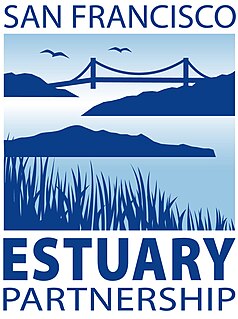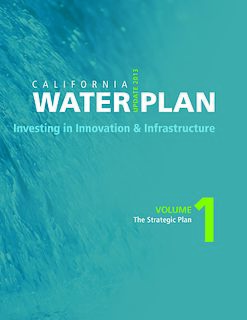Proposition 50 was a proposition in the state of California on the November 5, 2002 ballot. The proposition passed with 3,808,594 (55.4%) votes in favor and 3,076,333 (44.6%) against. It was placed on the ballot through the initiative process.
The California Coastal Conservancy is a state agency in California established in 1976 to enhance coastal resources and access.
A water board is a regional or national organisation that has very different functions from one country to another. The functions range from flood control and water resources management at the regional or local level, water charging and financing at the river basin level (France), bulk water supply, regulation of pricing and service quality of drinking water supply at the national level (Kenya) or the coordination of water resources policies between various Ministries and agencies at the national level together with the regulation of drinking water supply.
Michael J. Machado is a Democratic politician from Linden, California. He served from 2000 to 2008 in the California State Senate. Machado represented the 5th District, which includes the cities of Tracy, Manteca and Stockton in San Joaquin County; Suisun City, Fairfield, Dixon and Vacaville in Solano County; Davis, West Sacramento, Winters and Woodland in Yolo County; as well as Walnut Grove and a portion of Elk Grove in Sacramento County.
The Hawaiʻi Department of Land and Natural Resources (DLNR) is a part of the Hawaiʻi state government dedicated to managing, administering, and excerising control over public lands, water resources and streams, ocean waters, coastal areas, minerals, and other natural resources of the state of Hawaiʻi. The mission of the Hawaiʻi Department of Land and Natural Resources is to "enhance, protect, conserve and manage Hawaiʻi's unique and limited natural, cultural and historic resources held in public trust for current and future generations of the people of Hawaiʻi nei, and its visitors, in partnership with others from the public and private sectors." The organization oversees over 1.3 million acres of land, beaches, and coastal waters and 750 miles of coastal land.
The Water Resources Development Act of 1996 is part of Pub.L. 104–303, was enacted by Congress of the United States on October 12, 1996. Most of the provisions of WRDA 1996 are administered by the United States Army Corps of Engineers.
The Water Resources Development Act of 1999, Pub.L. 106–53, was enacted by Congress of the United States on August 17, 1999. Most of the provisions of WRDA 1999 are administered by the United States Army Corps of Engineers.
The Water Resources Development Act of 2000, Pub.L. 106–541, was enacted by Congress of the United States on December 11, 2000. Most of the provisions of WRDA 2000 are administered by the United States Army Corps of Engineers.
The Southern California Coastal Water Research Project (SCCWRP) is a research institute focusing on the coastal ecosystems of Southern California from watersheds to the ocean. SCCWRP was created as a joint powers authority (JPA), which is an agency formed when multiple government agencies have a common mission that can be better achieved by pooling resources and knowledge. The purpose of SCCWRP is to gather the necessary scientific information to allow member agencies to effectively and cost-efficiently steward the Southern California coastal environment.
Nonpoint source (NPS) water pollution regulations are environmental regulations that restrict or limit water pollution from diffuse or nonpoint effluent sources such as polluted runoff from agricultural areas in a river catchments or wind-borne debris blowing out to sea. In the United States, governments have taken a number of legal and regulatory approaches to controlling NPS effluent. Nonpoint water pollution sources include, for example, leakage from underground storage tanks, storm water runoff, atmospheric deposition of contaminants, and golf course, agricultural, and forestry runoff. Nonpoint sources are the most significant single source of water pollution in the United States, accounting for almost half of all water pollution, and agricultural runoff is the single largest source of nonpoint source water pollution. This water pollution has a number of detrimental effects on human health and the environment. Unlike point source pollution, nonpoint source pollution arises from numerous and diverse sources, making identification, monitoring, and regulation more complex.

The San Francisco Estuary Partnership (Partnership) is one of the 28 National Estuary Programs created in the 1987 Amendments to the Clean Water Act. The Partnership is a non-regulatory federal-state-local collaboration working to restore water quality and manage the natural resources of the San Francisco Bay-Sacramento–San Joaquin River Delta estuary. The Partnership works with over 100 municipalities, non-profits, governmental agencies, and businesses and helps develop, find funding for, and implement over 40 projects and programs aimed at improving the health of the estuary. The partnership either directly implements these projects, or administers and manages grants, holds educational workshops and highlights project results. The Partnership is also the official representative for the San Francisco Bay region to the Most Beautiful Bays in the World.
Water in Arkansas is an important issue encompassing the conservation, protection, management, distribution and use of the water resource in the state. Arkansas contains a mixture of groundwater and surface water, with a variety of state and federal agencies responsible for the regulation of the water resource. In accordance with agency rules, state, and federal law, the state's water treatment facilities utilize engineering, chemistry, science and technology to treat raw water from the environment to potable water standards and distribute it through water mains to homes, farms, business and industrial customers. Following use, wastewater is collected in collection and conveyance systems, decentralized sewer systems or septic tanks and treated in accordance with regulations at publicly owned treatment works (POTWs) before being discharged to the environment.

The California Water Plan is the State of California’s long-term strategic plan for managing and developing water resources throughout the state. The Water Plan is mandated by California Water Code Sections 10004–10013, and the California Department of Water Resources (DWR) is required to update the plan every five years. Although the Water Plan does not create mandates, propose specific projects, or authorize funding, Water Code Section 10005 defines the plan and its updates as “the master plan which guides the orderly and coordinated control, protection, conservation, development, management and efficient utilization of the water resources of the state.” Eleven updates to the plan have been prepared since 1957.
The Sustainable Groundwater Management Act (SGMA) is a three-bill package that passed the California state legislature and was signed into California state law by Governor Jerry Brown in September 2014. Its purpose is to ensure better local and regional management of groundwater use and it seeks to have a sustainable groundwater management in California by 2042. It emphasizes local management and formed groundwater sustainability agencies (GSAs) from local and regional authorities.

The Groundwater Ambient Monitoring and Assessment Program (GAMA) is an all-inclusive monitoring program for groundwater that was implemented in 2000 in California, United States. It was created by the California State Water Resources Control Board as an improvement from groundwater programs that were already in place. GAMA monitors various aspects in groundwater such as the water quality and allotment total through research projects conducted by multiple agencies both statewide and locally sourced. GAMA wants to improve public awareness for groundwater resources as well as improve monitoring on groundwater research across the state to assess potential hazards from this resource.

California state elections in 2018 were held on Tuesday, November 6, 2018, with the primary elections being held on June 5, 2018. Voters elected one member to the United States Senate, 53 members to the United States House of Representatives, all eight state constitutional offices, all four members to the Board of Equalization, 20 members to the California State Senate, and all 80 members to the California State Assembly, among other elected offices.








